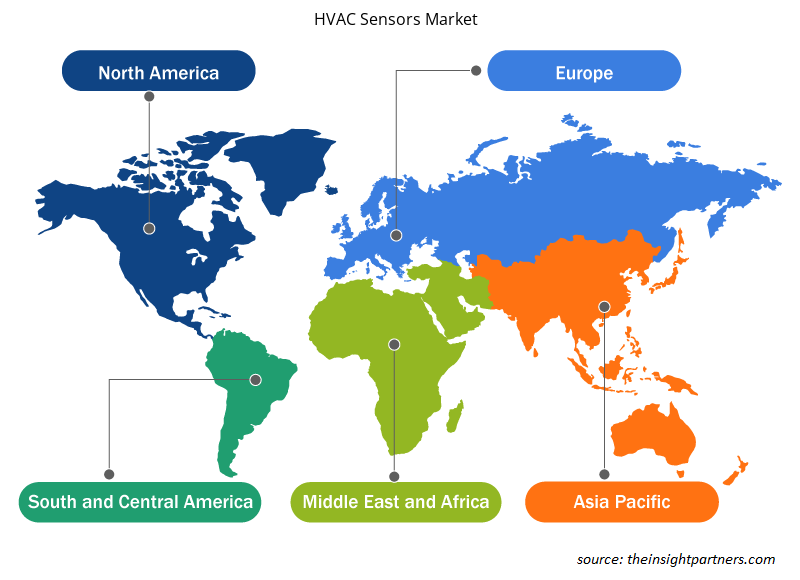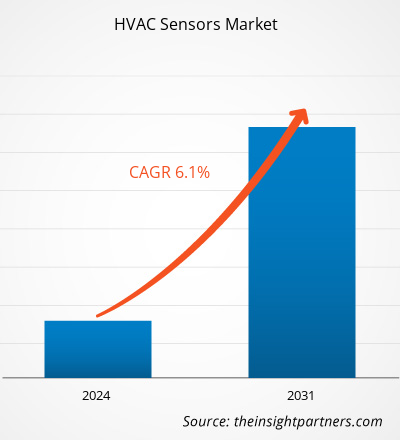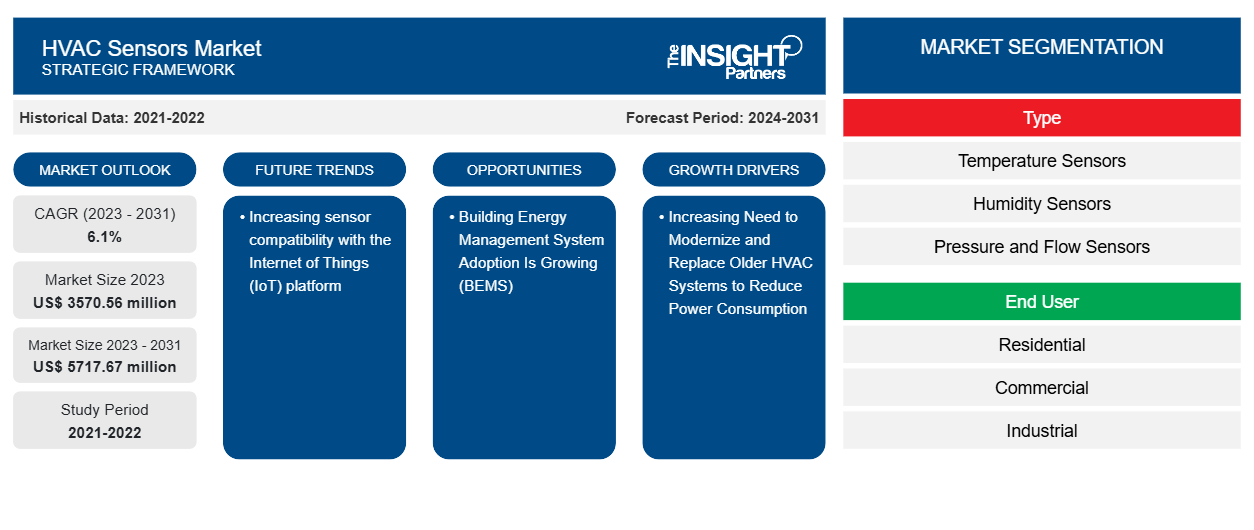预计到 2031 年,HVAC 传感器市场规模将从 2023 年的 35.7056 亿美元增至 57.1767 亿美元。预计 2023-2031 年市场复合年增长率为 6.1%。
传感器与物联网 (IoT) 平台的兼容性不断提高,很可能继续成为 HVAC 传感器市场的一个关键趋势。
HVAC 传感器市场分析
HVAC 传感器市场被多个行业所利用,例如商业、住宅、汽车等。如今,商业世界竞争激烈,因为领先的组织必须优先考虑环境保护、生产力、质量、安全和保障。在过去的几年里,HVAC 系统已广泛应用于世界各地的许多项目中。包括压力和温度传感器在内的众多传感器找到了使它们成为可能的用途。HVAC 系统为汽车和室内提供良好的空气质量和热舒适度。HVAC 传感器用于满足关注能源效率的各种最终用户的需求。它们有助于以低功耗提供适当维护的室内空间。
HVAC 传感器市场概览
HVAC 系统经常用于维护、控制,从而降低能源使用量。频率中包含一个模拟真实条件(如温度或目标环境)的音频设备。最重要的 HVAC 传感器类型有助于保持适当的温度,并通过区分输入温度与建筑物或室温来调整所需温度。对于包括工业、住宅和商业建筑在内的最终用户,HVAC 传感器可以管理、控制和监控各种操作,如气压、温度和质量。因此,由于节能的必要性,HVAC 传感器变得越来越普遍。
定制此报告以满足您的需求
您可以免费定制任何报告,包括本报告的部分内容、国家级分析、Excel 数据包,以及为初创企业和大学提供优惠和折扣
-
获取此报告的关键市场趋势。这个免费样品将包括数据分析,从市场趋势到估计和预测。
HVAC 传感器市场驱动因素和机遇
日益需要对旧式 HVAC 系统进行现代化改造和更换,以降低电力消耗
世界经济论坛估计,建筑物占能源相关二氧化碳排放量的 40% 以上,占全球能源消耗的近三分之一。世界绿色建筑委员会称,这些排放中约有三分之一是由建筑物运行所需的能源引起的,包括供暖、制冷和供电。据 Iota Communications 称,普通办公楼每年的电力支出约为 30,000 美元。在商业建筑中,暖通空调系统通常消耗的能源最多。根据美国能源部的估计,暖通空调系统通常占建筑物能源消耗的 35%。在疫情期间,对具有空气过滤特性的暖通空调系统的需求有所增加。更新的通风系统通过过滤空气和降低空气中的污染物(例如含病毒的颗粒)对公共卫生起着至关重要的作用。
建筑能源管理系统的采用正在增长(BEMS)
尽管暖通空调系统成本高昂,但建筑物离不开暖通空调系统。澳大利亚气候变化、能源、环境和水资源部估计,暖通空调系统平均消耗建筑物总能耗的 40%和基本能耗的 70%。基于计算机的自动化系统,即建筑能源管理系统 (BEMS),负责监控和调节建筑物内所有与能源相关的系统,包括机械和电气设备。通过实现对能源系统和供应的精确和自动化控制,能源管理可防止公司产生不必要的能源支出。Radiocrafts 称,借助 BEMS,公司可将目前的能源使用量减少 10% 至 30%。由于俄罗斯和乌克兰之间的冲突,欧盟的能源价格飞涨。因此,预计建筑能源管理系统 (BEMS) 将在预测期内为暖通空调参与者带来新的机会。
HVAC 报告细分分析
有助于得出 HVAC 分析的关键部分是类型和最终用户。
- 根据类型,HVAC 分为温度传感器、湿度传感器、压力和流量传感器、运动传感器、烟雾和气体传感器等。温度传感器部分在 2023 年占据了更大的市场份额。
根据最终用户,HVAC 传感器市场分为住宅、商业和工业。
暖通空调传感器市场份额(按地区)分析
HVAC 传感器市场报告的地理范围主要分为五个区域:北美、亚太地区、欧洲、中东和非洲以及南美/南美和中美洲。由于拥有大量现代化、发达的基础设施,包括商业建筑、工业设施和住宅物业,北美拥有最大的 HVAC 传感器和控制器市场份额。由于拥有复杂 HVAC 系统的建筑物众多,因此 HVAC 传感器和控制器的市场规模庞大。
HVAC 传感器市场区域洞察
Insight Partners 的分析师已详尽解释了预测期内影响 HVAC 传感器市场的区域趋势和因素。本节还讨论了北美、欧洲、亚太地区、中东和非洲以及南美和中美洲的 HVAC 传感器市场细分和地理位置。

- 获取 HVAC 传感器市场的区域特定数据
HVAC 传感器市场报告范围
| 报告属性 | 细节 |
|---|---|
| 2023 年的市场规模 | 35.7056亿美元 |
| 2031 年市场规模 | 57.1767亿美元 |
| 全球复合年增长率(2023 - 2031) | 6.1% |
| 史料 | 2021-2022 |
| 预测期 | 2024-2031 |
| 涵盖的领域 |
按类型
|
| 覆盖地区和国家 |
北美
|
| 市场领导者和主要公司简介 |
|
HVAC 传感器市场参与者密度:了解其对业务动态的影响
暖通空调传感器市场正在快速增长,这得益于终端用户需求的不断增长,而这些需求又源于消费者偏好的不断变化、技术进步以及对产品优势的认识不断提高等因素。随着需求的增加,企业正在扩大其产品范围,进行创新以满足消费者的需求,并利用新兴趋势,从而进一步推动市场增长。
市场参与者密度是指在特定市场或行业内运营的企业或公司的分布情况。它表明在给定市场空间中,相对于其规模或总市场价值,有多少竞争对手(市场参与者)存在。
在 HVAC 传感器市场运营的主要公司有:
- 西门子股份公司
- 艾默生电气公司
- 霍尼韦尔国际公司
- 江森自控有限公司
- 施耐德电气
- 泰科电子 (TE) 有限公司
免责声明:上面列出的公司没有按照任何特定顺序排列。

- 获取 HVAC 传感器市场顶级关键参与者概览
HVAC 传感器市场新闻和最新发展
HVAC 传感器市场通过收集主要和次要研究后的定性和定量数据进行评估,其中包括重要的公司出版物、协会数据和数据库。以下是言语和语言障碍市场的发展和策略列表:
- 2023 年 10 月,Sensata Technologies 宣布推出 Sensata Resonix RGD 传感器,这是首款获得 UL 认证的泄漏检测传感器,适用于供暖、通风和空调 (HVAC) 设备中使用的多种 A2L 制冷剂气体。新的泄漏检测传感器支持 HVAC 制造商向全球变暖影响较小的制冷剂过渡。(来源:Sensata Technologies,新闻稿)
- 2023 年 1 月,Third Reality 推出了一款温度和湿度传感器。(来源:Third Reality,新闻稿)
HVAC 传感器市场报告覆盖范围和交付成果
“HVAC 传感器市场规模和预测(2021-2031 年)”报告对市场进行了详细分析,涵盖以下领域:
- 范围内所有主要细分市场的全球、区域和国家层面的市场规模和预测
- 市场动态,如驱动因素、限制因素和关键机遇
- 未来的主要趋势
- 详细的 PEST/波特五力分析和 SWOT 分析
- 全球和区域市场分析涵盖关键市场趋势、主要参与者、法规和最新市场发展
- 行业格局和竞争分析,涵盖市场集中度、热点图分析、知名参与者和最新发展
- 详细的公司简介
- 历史分析(2 年)、基准年、预测(7 年)及复合年增长率
- PEST和SWOT分析
- 市场规模、价值/数量 - 全球、区域、国家
- 行业和竞争格局
- Excel 数据集
近期报告
相关报告
客户评价
购买理由
- 明智的决策
- 了解市场动态
- 竞争分析
- 客户洞察
- 市场预测
- 风险规避
- 战略规划
- 投资论证
- 识别新兴市场
- 优化营销策略
- 提升运营效率
- 顺应监管趋势























 获取免费样品 - HVAC传感器市场
获取免费样品 - HVAC传感器市场